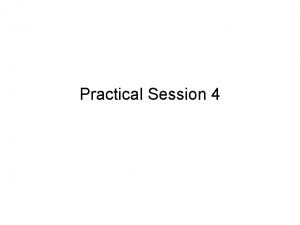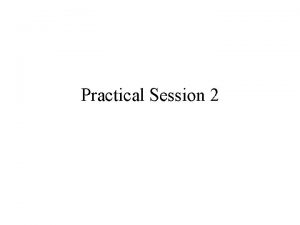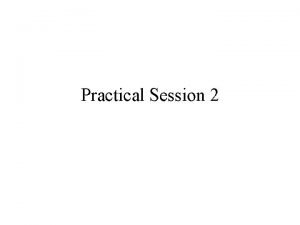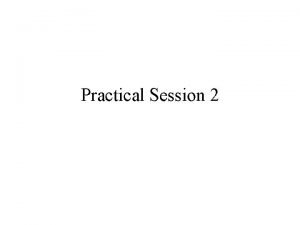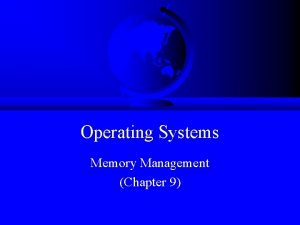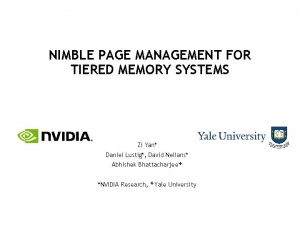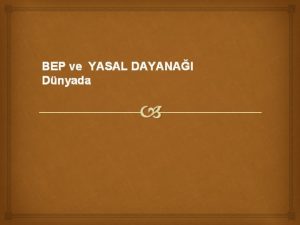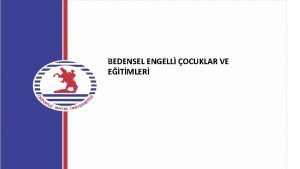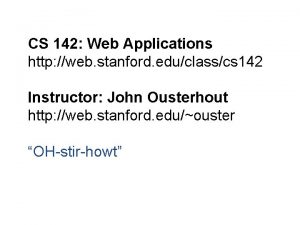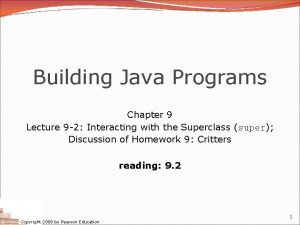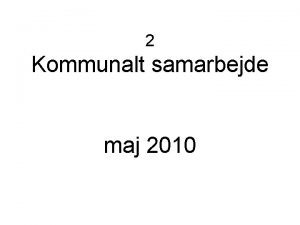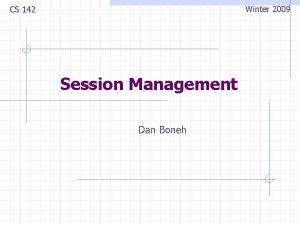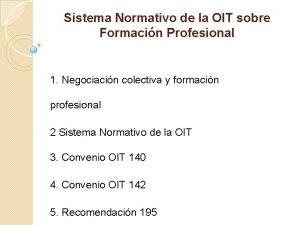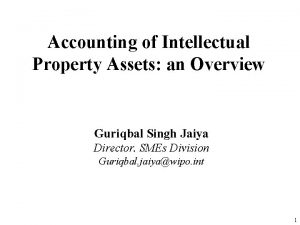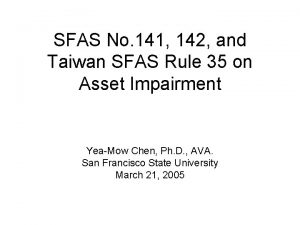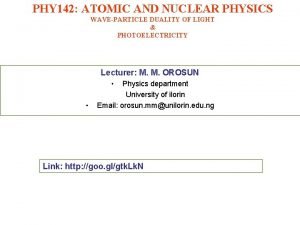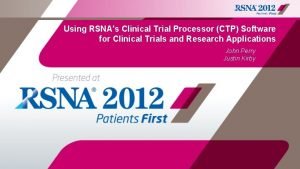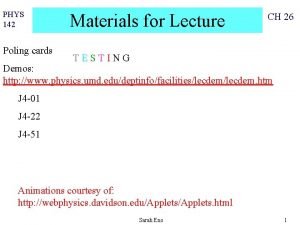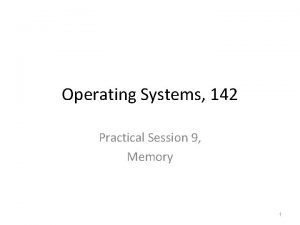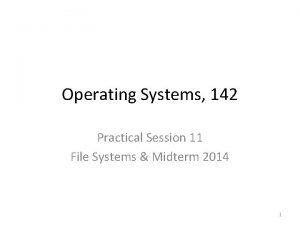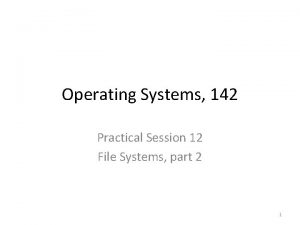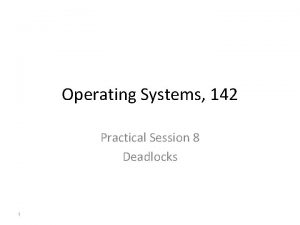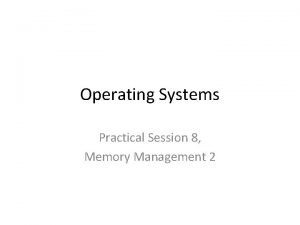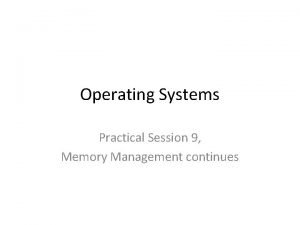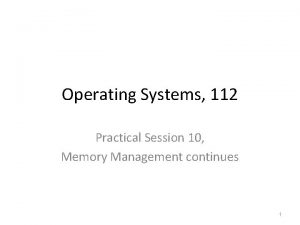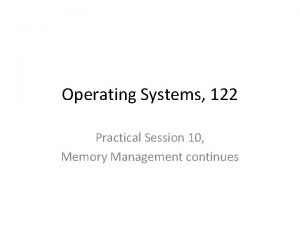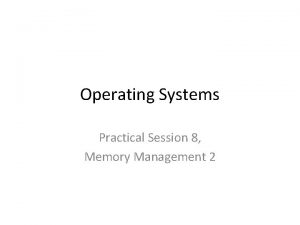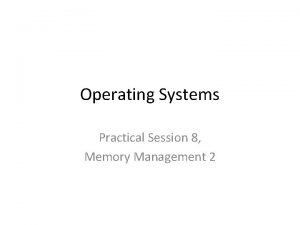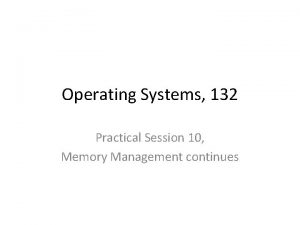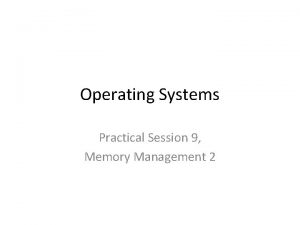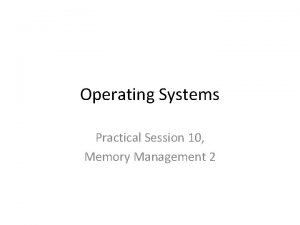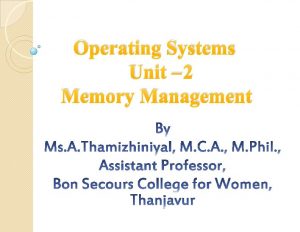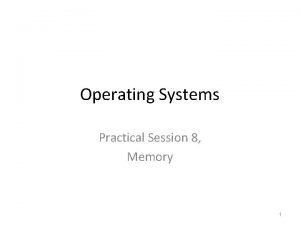Operating Systems 142 Practical Session 10 Memory Management




















![Question 2 Program A: Program B: int i, j, a[100][100]; for (i = 0; Question 2 Program A: Program B: int i, j, a[100][100]; for (i = 0;](https://slidetodoc.com/presentation_image_h2/8fad22d591d29a247a6ee03f3db4695c/image-21.jpg)
![Question 2 Array a is stored in a[0][0], a[0][1]. . . in virtual pages Question 2 Array a is stored in a[0][0], a[0][1]. . . in virtual pages](https://slidetodoc.com/presentation_image_h2/8fad22d591d29a247a6ee03f3db4695c/image-22.jpg)


















- Slides: 40

Operating Systems, 142 Practical Session 10, Memory Management continues

Quick recap PAGE REPLACEMENT ALGORITHMS 2

Optimal • Assumes the memory manager knows the “future” sequence of page references • The optimal algorithm: page out the page that will be used latest • Problem: Problem the manager doesn’t know the future sequence of requests! 3

FIFO/FIFO Second-chance • FIFO – First page In will be the First page taken Out – Problem: Problem we may be removing a page that will be constantly in use: • Assume memory size of 2 frames, and take the following sequence of page requests: 1, 2, 3, 1… • FIFO second-chance: – Add a reference bit that will be turned on whenever the page is accessed – When a “swap out” is needed: go over the pages from the oldest to newest and if the page’s reference bit is on, clear it; otherwise remove the page. • Both FIFO and FIFO second-chance can be implemented as a circular queue: the “clock algorithm”. 4

2 nd chance FIFO (clock) 5

Least Recently Used (LRU) • If we need to remove a page, then the Least Recently Used page will be chosen § Throw out the page that has been unused for longest time period • Problem: Problem have to keep “history” and remember when a page was referenced § Counter for each page, updated on every memory reference! • LRU can be approximated: – Shift counter o Updating every page reference can be too often! => shift only every clock tick (modified version of NFU, NFU also known as aging) – Use n 2 bit matrix o Hardware LRU algorithm, where n is the number of page frames 6

Modified NFU (Aging) Pages Page references Clock tick 0 Clock tick 1 Clock tick 2 Clock tick 3 Clock tick 4 1 0 1 1 0 0 0 1 1 0 0 10000000 11100000 11110000 01111000 1 0000 10000000 11000000 01100000 10110000 2 10000000 01000000 00100000 00010000 1000 3 00000000 10000000 01000000 00100000 4 10000000 11000000 01100000 10110000 01011000 5 10000000 01000000 10100000 01010000 00101000 7

Hardware LRU algorithm (bit tables) 0 1 2 3 0 1 2 3 0 0 1 1 1 0 0 0 0 1 0 0 1 1 1 0 0 0 2 0 0 0 0 2 1 1 0 1 1 1 0 0 2 1 1 0 1 3 0 0 0 3 1 1 1 0 0 0 1 2 3 0 1 2 3 0 0 0 1 1 1 0 0 1 0 1 1 0 0 0 0 0 1 0 0 2 1 1 0 1 1 1 0 0 0 0 0 3 1 1 1 0 1 1 Reference string is: 0, 1, 2, 3, 2, 1, 0, 3, 2, 3 8

Quick recap: global vs. local • The scope of the page replacement policy can be: – Local: choose a page to remove only among the pages of the process that caused the page fault – Global: choose a page to remove from all pages in main memory, independent of the process • Global policies are more efficient – Dynamically allocate page frames among the runnable processes. This is useful when the size of a WS is dynamically changing. • Local policies may have variable allocation of pages per process (“working set”) 9

Local vs. global algorithms • Adding page A 6: A 6 Last reference time Local policy Global policy 10

Quick recap: WS-Clock • Modified version of the “clock algorithm” that takes into consideration the current working set of a process • WS-Clock have a parameter τ • Each page in memory has a reference bit and a field containing the last time it was used measured by the process’s internal clock • A page will be chosen for removal if both conditions apply: – Its reference bit is 0 – The time elapsed since the last reference to the page is bigger than τ (takes into account each process virtual time for computation) 11

Dynamic set – WSClock Example 3 processes: p 0, p 1 and p 2 current (virtual) times of the 3 processes are Tp 0 = 50; Tp 1 = 70; Tp 2 = 90 WSClock: replace when Tp - ref(frame) > the minimal distance (“window size”) is = 20 The clock hand is currently pointing to page frame 4 Frames 0 1 2 3 4 5 6 7 8 9 10 reference bit 0 0 1 1 1 0 0 1 0 Process ID 0 1 2 1 0 0 1 2 2 Last reference 10 30 42 65 81 57 31 37 31 47 55 13 39 Tp - ref(frame) 13 12

Question 1: 2007 a : ( הבאה inverted page table) נתונה טבלת הדפים ההפוכה Process / page Ref-bit Virtual time P 0 / 3 0 20 P 2 / 0 0 60 P 0 / 5 1 30 P 1 / 3 1 100 P 0 / 6 1 10 P 2 / 5 0 70 P 1 / 7 1 20 P 1 / 2 1 20 13


Question 1: 2007 a 0 1 2 3 4 5 6 7 15



Question 1: 2007 a 0 0 0 18


Question 1: 2007 a 20
![Question 2 Program A Program B int i j a100100 for i 0 Question 2 Program A: Program B: int i, j, a[100][100]; for (i = 0;](https://slidetodoc.com/presentation_image_h2/8fad22d591d29a247a6ee03f3db4695c/image-21.jpg)
Question 2 Program A: Program B: int i, j, a[100][100]; for (i = 0; i < 100; i++) { for (j = 0; j < 100; j++) { a[i][j] = 0; } } for (j = 0; j < 100; j++) { for (i = 0; i < 100; i++) { a[i][j] = 0; } } Assume that the array a is stored consecutively: a[0, 0], a[0, 1]. . . and also assume that the size of each entry is one word The virtual memory has a page size of 200 words The program code is in address 0 -199 in the virtual memory. a[0][0] is at virtual address 200. We run both programs on a machine with physical memory of 3 frames Where the code of the program is in the 1'st frame and the other two are empty. If the page replacement algorithm is LRU, how many page faults will there be in each of the programs? Explain. 21
![Question 2 Array a is stored in a00 a01 in virtual pages Question 2 Array a is stored in a[0][0], a[0][1]. . . in virtual pages](https://slidetodoc.com/presentation_image_h2/8fad22d591d29a247a6ee03f3db4695c/image-22.jpg)
Question 2 Array a is stored in a[0][0], a[0][1]. . . in virtual pages 1. . 50 The reference string (specifying only possible page faults) of program A will be: 0, 1, 0, 2, 0, 3. . . 50 Ø We'll get a total of 50 page faults. The reference string of B will be: 0, 1, 0, 2. . . , 0, 50, 0, 1, 0, 2. . 0, 50, . . Ø Leading to a total of 5000 page faults. Note that due to the use of the LRU algorithm, page 0 will be in memory at all times. 22

Question 3 Consider the following page reference string: 7, 0, 1, 2, 0, 3, 0, 4, 2, 3, 0, 3, 2, 1, 2, 0, 1, 7, 0, 1 Assuming that the memory size is 3 frames, how many page faults would occur for the following algorithms: 1. 2. 3. FIFO LRU Optimal Note: Remember that all frames are initially empty, so your first unique pages will all cost one fault each. 23

Question 3: FIFO 15 page faults 7 0 1 2 7 7 7 0 0 3 0 4 2 3 0 2 2 2 4 4 4 0 0 3 3 3 2 1 1 1 0 0 0 3 2 1 2 0 0 2 2 3 3 0 1 7 0 1 0 7 7 7 1 1 1 0 0 3 2 2 2 1 24

Question 3: LRU 12 page faults 7 0 1 2 7 7 7 2 0 0 1 0 3 0 4 2 3 0 3 2 1 2 0 1 7 2 4 4 4 0 1 1 1 0 0 3 3 3 0 0 1 3 3 2 2 2 0 1 25

Question 3: Optimal 9 page faults 7 0 1 2 0 3 0 4 2 3 0 3 2 1 2 0 1 7 7 2 2 2 7 0 0 4 0 0 0 1 1 3 3 3 1 1 0 1 26


Question 4 – 2001 a 1 2 3 4 2 1 5 6 2 1 2 3 7 6 3 2 1 2 3 4 2 1 5 6 2 1 2 3 7 6 3 1 2 3 4 2 1 5 6 6 1 2 3 7 6 1 1 3 4 2 1 5 5 6 1 2 2 7 3 4 4 5 6 1 1 1 3 3 4 5 5 4 4 p p p 6 ∞ 5 3 4 Page fault p p distance ∞ ∞ 3 4 p p ∞ ∞ 4 4 2 . 1 28


Question 4 – 2001 a. 2 Page fault 1 2 3 4 2 1 5 6 2 1 2 3 7 6 3 2 1 2 3 4 4 4 5 6 2 1 1 3 7 6 6 2 1 2 3 3 3 4 5 6 2 2 1 3 7 7 6 1 2 2 2 3 4 5 6 6 2 1 3 3 7 1 1 1 2 3 4 5 5 6 2 1 1 3 1 2 3 4 4 5 6 2 2 1 1 1 3 3 4 5 5 4 4 p p p 30


Question 5 – 2005 a b a a c b a b e f g e f e b b a f d b a a b e f h f e b b b a a a c c e e f f f g b a a a a c c c e e f f g g g b a d d d c c c e e e f f g g b b b a d e e e e f f f g g b b a a a d e f f f g g g b b a a d d d e f h h h Page p p fault p p p p p Where: P 11 = a; P 12 = b; P 13 = c; P 14 = d; P 21 = e; P 22 = f; P 23 = g; P 24 = h; Bold is used to represent pages which have their ref bit on. 32

Question 5 – 2005 a • We can see that both processes usually refer to pages 1 and 2 often (a, b and e, f) and rarely to other pages. • Since FIFO-second-chance is a global algorithm, we get for the above reference string, that pages from the working set of a process are sometimes paged out. • Whenever page 3 or 4 (for either process) are referenced, the last two pages used by each process are 1 and 2. So with a time window of size 2, whenever pages 3 or 4 are requested, pages 1 and 2 of both processes will be in the working set of the specific process and will not be paged out by WSClock. 33

Question 5 – 2005 a • If you look at the string closely, you could see that the working set of each process is at least of size 2. The total memory size is 5. • The processes are running in sequence, first process 1, then 2, then 3, then again 1, 2, 3… • When some process x continues its run, we know that there were two other processes which ran before him and needed at least 2 pages. This means that the memory contains at least 4 pages not belonging to process x (saved from its last run). • The remaining memory is not enough for x’s current run and it will have to page out other page(s). This will result in not having the pages of the next process in memory, which will repeat the process. • The total sum of the working set is bigger than the size of the memory. This situation is called thrashing and is solved by the OS by swapping out one of the processes to the backing store (disk). 34

Question 6 Consider the following virtual page reference string: 0, 1, 2, 3, 0, 0, 1, 2, 3 Which page references will cause a page fault when a basic clock replacement algorithm is used? Assume that there are 3 page frames and that the memory is initially empty. Show all page faults (including frame loading). 35

Question 6 Page fault 0 1 2 3 0 0 1 2 3 *0 0 0 *3 3 *2 2 *1 1 1 *0 *0 0 0 *3 *2 2 *1 1 1 pf pf Where: * represents the placement of the clock’s “hand” before the request pf represents a page fault 36



Question 7 – 2006 a CPU utilization לבין high level scheduling הסבירו את הקשר בין : הגרף הבא degree of multiprogramming 39

 Practical session definition
Practical session definition Practical session meaning
Practical session meaning Practical session meaning
Practical session meaning Multipicand
Multipicand Address binding
Address binding Module 4 operating systems and file management
Module 4 operating systems and file management Nimble page management for tiered memory systems
Nimble page management for tiered memory systems Virtual memory in operating system
Virtual memory in operating system Virtual memory os
Virtual memory os Prime numbers between 200 and 300
Prime numbers between 200 and 300 Pl94-142
Pl94-142 Pl-94-142
Pl-94-142 18 numero romano
18 numero romano Stanford cs 142
Stanford cs 142 Psalms 142 meaning
Psalms 142 meaning Mat 142
Mat 142 770 000 in scientific notation
770 000 in scientific notation Phm142
Phm142 Cse 142 critters
Cse 142 critters Generel helbredsundersøgelse læ 142
Generel helbredsundersøgelse læ 142 Stanford cs 142
Stanford cs 142 Convenio 142 oit
Convenio 142 oit Gaap accounting for intellectual property
Gaap accounting for intellectual property Fasb 142
Fasb 142 Physics 142
Physics 142 Dicom supplement 142
Dicom supplement 142 Phys 142
Phys 142 12 742 km in miles
12 742 km in miles 142 cooper river drive
142 cooper river drive 100000/142
100000/142 Prototypes in semantics
Prototypes in semantics Explicit memory
Explicit memory Long term memory vs short term memory
Long term memory vs short term memory Internal memory and external memory
Internal memory and external memory Primary memory and secondary memory
Primary memory and secondary memory Memory swaping
Memory swaping Which memory is the actual working memory?
Which memory is the actual working memory? Virtual memory and cache memory
Virtual memory and cache memory Virtual memory in memory hierarchy consists of
Virtual memory in memory hierarchy consists of Eidetic memory vs iconic memory
Eidetic memory vs iconic memory Symmetric shared memory architecture
Symmetric shared memory architecture
